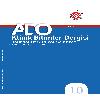110R Anacına Aşılı Merlot Üzüm Çeşidi Genç Omcalarına Farklı Dozlarda Uygulanan Trichoderma harzianum ve Bacillus subtilis’ in II. Söküm Dönemindeki Etkileri
Merlot, 110R, Bacillus subtilis, Trichoderma harzianum, Vitis vinifera L., söküm dönemi
Different Doses Effects of Trichoderma harzianum and Bacillus subtilis on Young plants 110R/Merlot II. Uprooting Period
Merlot, 110R, Bacillus subtilis, Trichoderma harzianum, Vitis vinifera L., uprooting period,
___
- Ağaoğlu YS (1999) Bilimsel ve Uygulamalı Bağcılık Cilt I: Asma Biyolojisi Kavaklıdere Eğitim Yayınları No: 1. Ankara. 205s.
- Al-Zubaidi HK (1992) Almqaoma Alhiowiya llafat. Dar alkutup lltibaa ve alneshir. Jamiat almusul. 440s.
- Arıkan S, Ipek M, Pirlak L (2013) Effects of Plant Growth Promoting Rhizobacteria (PGPR) on Yield and Fruit Quality of Quince. 2013 International Conference on Agriculture and Biotechnology IPCBEE 60. IACSIT Press, Singapore.
- Aslantas R, Cakmakci R, Sahin F (2007) Effect of Plant Growth Promoting Rhizobacteria on Young Apples Trees Growth and Fruit Yield Under Orchard Conditions. Scientia Horticulture 4: 371-377.
- Björkman T, Blanchard LM, Harman GE (1998) Growth Enhancement of shrunken-2 (sh2) Sweet Corn by Trichoderma harzianum 1295-22: Effect of Environmental Stress. Journal of the American Society for Horticultural Sciences 123(1):35-40.
- Bora T (2002) Bitki Hastalıklarıyla Biyolojik Savaşta Gelişmeler ve Türkiye’ de Durum. Türkiye 5. Biyolojik Mücadele Kongresi. 4-7 Eylül 2002. Erzurum. 14s.
- Chen J (2006) The Combined of Chemical and Organic Fertilizers and/or Biofertilizer for Crop Growth and Salt Fertility. International Workshop on Sustained Management of the Soil-Rhizosphere System for Efficient Crop Production and Fertilizer Use. (Bangkok) 10900: 16-20.
- Di Marco S, Osti F (2007) Applications of Trichoderma to prevent Phaeomoniella Chlamydospora Infections in Organic Nurseries. Phytopathologia Mediterranea 46 (1) 73-83.
- Esitken A, Karlidag H, Ercisli S, Turan M, Sahin F (2003) The Effect of Spraying a Growth Promoting Bacterium on the Yield, Growth and Nutrient Element Composition of Leaves of Apricot (Prunus armeniaca L. cv. Hacihaliloglu). Australian Journal of Agricultural Research 54: 377-380.
- Ghabrial SA, Suzuki N (2009) Viruses of Plant Pathogenic Fungi. Annual Review of Phytopathology 47(1): 353-384.
- Larkin RP (2004) Development of Integrated Biological and Cultural Approaches for Control of Powdery Scab and Other Soil Borne Disease. USDA, ARS, New England Plant, Soil, and Water Lab Univ. of Maine, Orone, ME O 44469.
- Mahmood MAS (2014) Production of Bio-Formula of Bacillus subtilis in Oculaum for Control of Damping off Disease Caused by Pythium aphanidermatum on Cucumber Plants Under Green House Condition. Agriculture Science Plant Protection. Tikrit University.
- Moses RT (2006) Biological and Chemical Control of Fungi Seedling Diseases of Cowpea. M.Sc. Thesis. Department of Microbiology and Plant Pathology. Fac. of Natural and Agricultural Sciences. University of Pretoria. 67pp.
- Muhammad S, Amusa A (2003) In-vitro Inhibition of Growth of Some Seedling Blight Inducing Pathogens by Compost-Inhabiting Microbs. Journal of Biotechnology 2: 161-164.
- Mervat AA, Shawky SM, Shaker GS (2012) Comparative Efficacy of Some Bioagents, Plant Oil and Plant Aqueous Extracts in Controlling Meloidogyne incognita on Growth and Yield of Grapevines. Annals of Agricultural Science 57(1): 7-18.
- Özaktan H, Aysan Y, Yıldız F, Kınay P (2010) Fitopatolojide Biyolojik Mücadele. Türkiye Biyolojik Mücadele Dergisi 1(1): 61-78.
- Raudales RE, McSpadden Gardener BB (2008) Microbial Biopesticides for the Control of Plant Diseases in Organic Farming. Agriculture and Natural Resources Fact Sheet. HYG-3310-08. The Ohio State University Extension. 5p.
- Sabir A, Yazici MA, Kara Z, Sahin F (2012) Growth and Mineral Acquisition Response of Grapevine Rootstocks (Vitis spp.) to Inoculation with Different Strains of Plant Growth-Promoting Rhizobacteria (PGPR). Journal of Science Food and Agriculture 92(10): 2148-2153.
- Szczech M, Shoda M (2004) Biocontrol of Rhizoctonia Damping - off of Tomato by Bacillus subtilis Combined with Burkholderia Cepacia. Phytopathology 152: 549-556.
- Şahin F (2010) Organik Bitkisel Üretimde Biyoteknoloji ve Ar-Ge. Türkiye IV. Organik Tarım Sempozyumu, 28 Haziran - 1 Temmuz 2010. Erzurum (Çağrılı Bildiri).
- Thomas C (2009) Managing Plant Diseases With Biofungicides. Virginia Cooperative Extension Virginiatech. Virginia Polytechnic Institute and State University. 2906-1298. 3p.
- Yedidia I, Benhamou N, Kapulnik Y, Chet I (2000) Induction and Accumilation of PR Proteins Activity during Early Stages of Root Colonization by the Mycoparasite Trichoderma harzianum Strain T203. Plant Physiology and Biochemistry 38: 863-873.
- Yedidia I, Srivastva AK, Kapulnik Y, Chet I (2001) Effect of Trichoderma harzianum on Microelement Concentrations and Increased Growth of Cucumber Plants. Plant and Soil 235: 235-242.
- Yonsel Ş, Demir M (2011) Kiraz ve Elma Fidanları ve Domates Fidelerinde Trichoderma harzianum KUEN 1585 Uygulamaları. Çanakkale Tarımı Sempozyumu Dünü, Bugünü Geleceği, 10234-11 Ocak 2011 Bildiriler 297-301.
- Zhou T, Paulitz C (1993) In-vitro and In-vivo effects of Pseudomonas spp. on Pythium aphanidermatum: Zoospores Behavior in Exudates and on the Rhizoplane of Bacteria Treated Cucumber Roots. Phytopathology 84(8): 872-876.
- ISSN: 1304-7787
- Yayın Aralığı: 2
- Başlangıç: 2004
- Yayıncı: Adnan Üniv. Ziraat Fak.
Süte Uygulanan Termal Olmayan İşlemler
Biyokömür; Tanımı, Kullanımı ve Tarım Topraklarındaki Etkileri
Develerde Karkas ve Et Kalite Özellikleri
Arazi Kullanımlarının Sınıflandırılmasında Piksel ve Obje Tabanlı Sınıflandırmanın Karşılaştırılması
Ömer Alper ERDEM, Şükran ÇAKLI
Su Ürünlerinde Metallotionein Proteinleri
Nermin YARAŞIR, Osman EREKUL, Ali YİĞİT
Yağlık Ayçiçeği Çeşitlerinde Oluşan Kuş Zararı Miktarları ve Verime Etkileri
